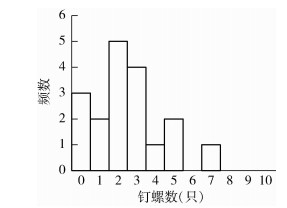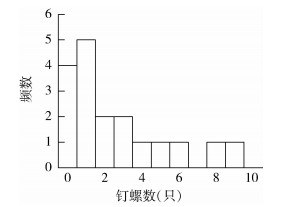扩展功能
文章信息
- 田建国, 黎桂福, 李俊, 韩荣荣, 彭丽霞
- TIAN Jian-guo, LI Gui-fu, LI Jun, HAN Rong-rong, PENG Li-xia
- 水网地区有螺泥土中钉螺聚集趋势及负二项分布拟合优度的研究
- Aggregation tendency and goodness of fit to negative binomial distribution of Oncomelania hupensis in the snail-obtainable soil of a waterway network
- 中国媒介生物学及控制杂志, 2020, 31(3): 358-361
- Chin J Vector Biol & Control, 2020, 31(3): 358-361
- 10.11853/j.issn.1003.8280.2020.03.023
-
文章历史
- 收稿日期: 2019-12-21
2 湖南省中医药研究院附属医院, 湖南 长沙 410006
2 The Attached Hospital of Chinese Medicine Institute of Hunan Province
钉螺(Oncomelania hupensis)在土壤中属离散性分布, 一般认为这种离散型属于二项分布[1-3]。既往的研究注重泥土表面的钉螺分布[3], 由于在自然环境中钉螺在泥土表面和泥土中活动是一个动态过程, 而泥土中钉螺呈何种分布研究较少, 对水网地区泥土中钉螺分布也鲜有报道。了解钉螺的分布规律有利于对钉螺种、株特征以及生物学理论的研究[4], 可以准确了解水网地区自然环境中螺情形成规律及变化规律, 从而为查螺、灭螺提供理论指导。
1 材料与方法 1.1 有螺水网地区土壤样本的采集及钉螺计数选择上海市青浦区练塘镇星浜村朱家埭河、青松港及断头浜新发现的有螺区作为样本采集点。采用系统抽样结合环境抽查法(双重查螺法)[3], 分别采集土壤20块, 每块土壤取土体积为330 cm×330 cm×7 cm。计数泥土表面钉螺。
1.2 仪器电子天平(型号:JJ1000, 江苏省常熟市双杰测试仪器厂); 自制土壤采样器, 体积为330 cm×330 cm×7 cm。
1.3 方法从采集的20块土壤样品中, 每块称取3份(每份500.0 g)样品, 共计60份样品, 采用双层箩筛水洗法对泥土样品中钉螺进行计数。
1.4 统计学分析数据采用Excel 2007软件汇总, 采用SAS 8.1软件进行统计分析。正态性检验采用Kolmogorov-Smirnov D检验; 采用均数、方差、峰度系数和偏度系数等对泥土中钉螺情况进行统计学描述; 3个地点泥土中钉螺数量比较采用非参数Wilcoxon秩和检验; 采用负二项分布对泥土中钉螺分布情况进行拟合优度检验。P < 0.05为差异有统计学意义。
2 结果 2.1 正态性检验此次检测的60份泥土中钉螺分布不符合正态分布(偏度系数=1.03, 峰度系数=0.71, D=0.167, P < 0.001)。
2.2 集中趋势检验从星浜村3个地区20块土壤样本情况看, 泥土中钉螺的均数>中位数, 峰度系数和偏度系数偏离0, 分布属正偏态分布; 方差>均数, 属聚集性分布, 见表 1。从3个地块的钉螺频数分布可以看出, 泥土中钉螺的分布呈正偏态分布, 结果见图 1~3。

|

|
| 图 1 上海市朱家埭河钉螺频数分布 Figure 1 The frequency distribution of Oncomelania hupensis in Zhujiadai river, Shanghai |
| |

|
| 图 2 上海市青松港钉螺频数分布 Figure 2 The frequency distribution of Oncomelania hupensis in Qingsonggang, Shanghai |
| |

|
| 图 3 上海市断头浜钉螺频数分布 Figure 3 The frequency distribution of Oncomelania hupensis in Duantoubang, Shanghai |
| |
非参数Wilcoxon秩和检验结果显示, 3个地区泥土中钉螺数差异无统计学意义(Z=0.405, P=0.815), 见表 2。

|
经负二项分布的拟合优度检验, χ2=1.844, P=0.765, 水网地区有螺泥土中钉螺服从负二项分布, 见表 3。

|
钉螺在泥土表面服从负二项分布已经得到证实[1-3], 但钉螺在泥土中分布服从何种分布报道较少。本研究对抽取样本的泥土中钉螺聚集趋势及负二项分布拟合优度进行研究, 结果显示, 泥土中钉螺属聚集性、正偏态分布。抽取的3个地区泥土单位重量中钉螺均数差异无统计学意义[5], 泥土中钉螺也服从负二项分布。
钉螺在自然界中的繁殖分布受到多种因素影响, 包括温度、湿度、土壤、植被、地貌、水文、水流动力等。其中水是钉螺繁殖生存的必需要素, 所有钉螺都是沿水系分布。有研究认为土壤含水量28%~38%最适合于钉螺生长[6-11], 我们既往的研究发现钉螺的活动与气象因素有关, 如温度和阴晴状况会影响到钉螺的活动, 不同的季节钉螺会出现冬眠、夏蛰等现象, 雨后钉螺会表现出迁徙、爬高等活动能力[12-13], 上述各种因素导致钉螺在泥土中和泥土表面形成一个动态的活动过程。综上所述, 钉螺在一个地区的生长、繁殖受环境等诸多因素的影响, 因此不表现出随机和均匀分布, 而表现出聚集性负二项分布[14], 但也有研究认为, 受不同月份和环境变化影响, 钉螺会出现不符合负二项分布的情况[15]。
本次研究认为泥土中钉螺与泥土表面钉螺一样均属聚集性、离散型分布, 服从负二项分布, 这与环境因素影响和钉螺的生存习性有关, 表现出钉螺在泥土表面和泥土内活动呈现一个动态的过程。谢法仙等[14]研究认为, 一个地区的钉螺经过较长时间稳定的生存, 形成高密度核心分布时, 才会符合负二项分布。我们认为这一论点支持负二项分布拟合优度检验, 可用于螺点形成的时间和规律判定, 通过一个地区中钉螺在泥土中的分布规律负二项分布检验, 可以推断螺点是新生螺点还是陈旧性螺点, 从而为既往的查螺效果和查螺效果质控及灭螺后的效果跟踪判定提供较为科学的判定依据。
| [1] |
苏德隆.苏德隆教授论文选集[M].天津: 天津科学技术出版社, 1995: 97-101. Su DL. Selected collections of professor SU De-long[M]. Tianjin: The Science and Technology Publish House of Tianjin, 1995: 97-101. |
| [2] |
孙振球.医学统计学[M]. 3版.北京: 人民卫生出版社, 2010: 103-108. Sun ZQ. Medical statistics[M]. 3rd ed. Beijing: People's Medical Publishing House, 2010: 103-108. |
| [3] |
中华人民共和国卫生部疾病控制司.血吸虫病防治手册[M]. 3版.上海: 上海科学技术出版社, 2000: 40-41. Department of Disease Control, Ministry of Health, People's Republic of China. Handbook of schistosomiasis control[M]. 3rd ed. Shanghai: Shanghai Scientific & Technical Publishers, 2000: 40-41. |
| [4] |
张志杰, 彭文祥, SenghuatO, 等. 广义负二项分布对钉螺分布的拟合[J]. 中国卫生统计, 2008, 25(1): 2-6. Zhang ZJ, Peng WX, Senghuat O, et al. Fitting generalized negative binomial distribution to the data of Oncomelania hupensis[J]. Chin J Health Stat, 2008, 25(1): 2-6. DOI:10.3969/j.issn.1002-3674.2008.01.001 |
| [5] |
方积乾, 孙振球.卫生统计学[M]. 6版.北京: 人民卫生出版社, 2011: 103-108, 11-23. Fang JQ, Sun ZQ. Health statistics[M]. 6th ed. Beijing: People's Medical Publishing House, 2011: 11-23, 103-108. |
| [6] |
张文馨.钉螺空间分布格局和抽样方法优化研究[D].南昌: 江西师范大学, 2015. Zhang WX. Study on spatial distribution pattern and sampling optimization of Oncomelania snails[D]. Nanchang: Jiangxi Normal University, 2015. |
| [7] |
张旭东, 杨晓春, 彭镇华. 钉螺分布与滩地环境因子的关系[J]. 生态学报, 1999, 2(2): 265-269. Zhang XD, Yang XC, Peng ZH. Relationships between the surviving Oncomelania and beaches environmental factors[J]. Acta Ecol Sin, 1999, 2(2): 265-269. DOI:10.3321/j.issn:1000-0933.1999.02.020 |
| [8] |
李源培, 王海银, 周艺彪, 等. 湖区钉螺孳生地的微生态环境对钉螺分布的影响[J]. 中华流行病学杂志, 2010, 31(2): 163-166. Li YP, Wang HY, Zhou YB, et al. Influence regarding micro-ecological environment of snail habitats in lake area on the distribution of snails[J]. Chin J Epidemiol, 2010, 31(2): 163-166. DOI:10.3760/cma.j.issn.0254-6450.2010.02.011 |
| [9] |
蔡新.食物与温度对湖北钉螺生长发育及繁殖率的影响研究[D].武汉: 湖北大学, 2012. Cai X. The influence of food and temperature on development and reproduction rate of Oncomelania hupensis[D]. Wuhan: Hubei University, 2012. |
| [10] |
李召军, 陈红根, 刘跃民, 等. 鄱阳湖区圩垸内外植被与钉螺分布关系研究[J]. 中国血吸虫病防治杂志, 2016, 18(6): 406-410. Li ZJ, Chen HG, Liu YM, et al. Studies on relationship between vegetation and snail distribution inside and outside embankment of Poyang Lake region[J]. Chin J Schisto Control, 2016, 18(6): 406-410. DOI:10.3969/j.issn.1005-6661.2006.06.002 |
| [11] |
李新祥, 王萍, 李冰. 江山市钉螺分布调查[J]. 预防医学, 2019, 31(8): 833-836, 840. Li XX, Wang P, Li B. A research on distribution of Oncomelania snails in Jiangshan city[J]. Prev Med, 2019, 31(8): 833-836, 840. DOI:10.19485/j.cnki.issn2096-5087.2019.08.021 |
| [12] |
田建国, 仲文江, 黎桂福, 等. 上海市青浦区钉螺再生性研究[J]. 中国媒介生物学及控制杂志, 2011, 22(2): 162-164. Tian JG, Zhong WJ, Li GF, et al. Study on the reproducibility of Oncomelania snails in Qingpu district of Shanghai[J]. Chin J Vector Biol Control, 2011, 22(2): 162-164. |
| [13] |
田建国, 黎桂福, 彭丽霞, 等. 模拟湖沼钉螺迁徙水网地区生长繁殖的适应性研究[J]. 中国媒介生物学及控制杂志, 2015, 26(4): 414-417. Tian JG, Li GF, Peng LX, et al. A research on the surviving and reproducing status of the imported Oncomelania snails from marshland areas to water network regions[J]. Chin J Vector Biol Control, 2015, 26(4): 414-417. DOI:10.11853/j.issn.1003.4692.2015.04.023 |
| [14] |
谢法仙, 朱达培, 钱珂, 等. 湖区草洲钉螺分布类型的研究[J]. 动物学报, 1980, 26(2): 165-169. Xie FX, Zhu DP, Qian K, et al. Studies on theoretical distribution of Oncomelania snails over marshland, Poyang Lake area[J]. Acta Zool Sin, 1980, 26(2): 165-169. |
| [15] |
王海银.日本血吸虫中间宿主-钉螺的螺口动力学研究[D].上海: 复旦大学, 2009. Wang HY. Research on intermediate host of Schistosoma japonicum-Oncomelania hupensis popuiation dynamic[D]. Shanghai: Fudan University, 2009. |
 2020, Vol. 31
2020, Vol. 31


